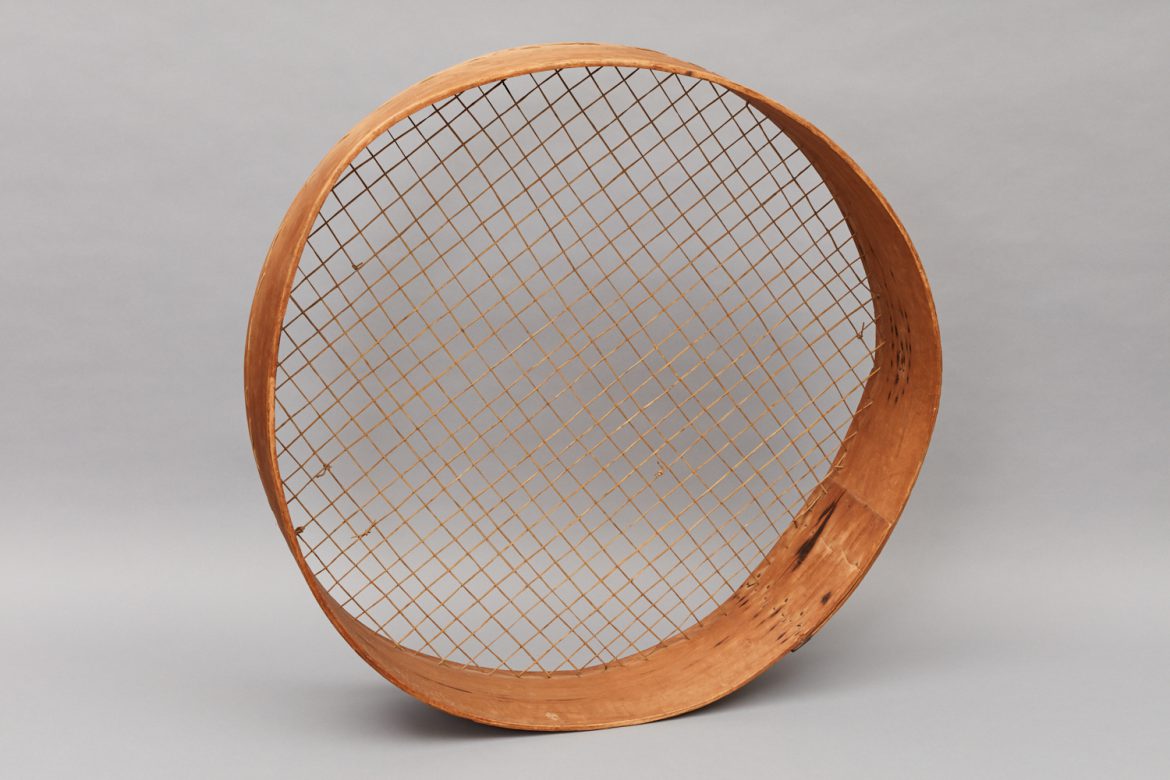
Corn Husk Sieve, Church Family, Canterbury, NH, ca. 1850, Shaker Museum | Mount Lebanon: 1950.4166.1. John Mulligan, photographer.
Shaker Museum | Mount Lebanon holds in its collection a generous variety of sieves. The smallest, under two inches in diameter, with a mesh of finely woven silk, was used to sift out impurities from medicinal powders. It is the largest sieve in the collection, however, that is the topic of this discussion. At nearly 40 inches […]
Shaker Museum | Mount Lebanon holds in its collection a generous variety of sieves. The smallest, under two inches in diameter, with a mesh of finely woven silk, was used to sift out impurities from medicinal powders. It is the largest sieve in the collection, however, that is the topic of this discussion. At nearly 40 inches in diameter and with a mesh of woven rawhide set at an average of an inch and a half apart, there are not a lot of things that would not fall through its holes. Sieves with a larger woven mesh are called riddles – from a Middle English term meaning “coarse sieve.” In fact when this riddle was acquired in the fall of 1950 from the Shakers at Canterbury, New Hampshire, it was explained that it had been “used for sifting corn husks which were used to stuff mattresses.” Corn husks, like straw, were commonly used to fill bags of coarse cotton ticking to make a hard mattress that was used on top of the ropes woven between the sides, head, and foot of a bedstead. The more firm the mattress, the less the ropes could be felt. Generally either a thin mattress of wool batting or, if available, a featherbed, would overlay the mattress for more comfort. Those who could not afford the softer options to cover the mattress had to make do with the lumpy feel and crinkly sound of sleeping directly on the corn husks.

Corn Husk Sieve, Church Family, Canterbury, NH, ca. 1850, Shaker Museum | Mount Lebanon: 1950.4166.1. John Mulligan, photographer.
It was standard, at least once a year, either to change the stuffing in the corn husk mattresses or merely “riddle” it to remove any dirt and bugs that had accumulated. At the North Family at Mount Lebanon as late as 1883 the Shakers must have still been using corn husk mattresses. In a journal kept by the gardeners it was noted that in the spring of that year: “All the teams drawing coal from the depot. The rest of us were cultivating & hoeing vegetable oyster in the First garden, helping the Sisters about riddling beds & cleaning house, washing wheat, grafting, &c.” “Riddling beds” would have involved bringing the mattresses outdoors, emptying the contents into a large riddle, like the one from Canterbury, shaking the contents until all the unwanted debris had fallen free, re-stuffing the mattresses, and returning them to their proper bedstead.

Corn Husk Sieve (detail of rawhide mesh), Church Family, Canterbury, NH, ca. 1850, Shaker Museum | Mount Lebanon: 1950.4166.1. John Mulligan, photographer.